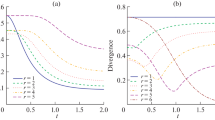Abstract
In the present work we discuss some new results and applications of the Kullback-Leibler residual divergence. It is shown that the residual divergence function is uniquely determined by the relative hazard rates of the constituent distributions. Some applications of this result in the series and parallel system reliability evaluations and in certain replacement policies are also suggested.

Similar content being viewed by others
References
Asadi, M., Ebrahimi, N., Hamedani, G. G. and Soofi, E. S (2005a). Minimum dynamic discrimination information models. Journal of Applied Probability42, 3, 643–660.
Asadi, M., Ebrahimi, N. and Soofi, E. S (2005b). Dynamic generalized information measures. Statistics & Probability Letters 71, 1, 85–98.
Dabrowska, D. M. and Doksum, K. A (1988). Estimation and testing in a two-sample generalized odds-rate model. Journal of the American Statistical Association83, 403, 744–749.
Di Crescenzo, A. and Longobardi, M. (2004). A measure of discrimination between past lifetime distributions. Statistics & Probability Letters 67, 2, 173–182.
Dileep Kumar, M., Sankaran, P. G. and Nair, N.U (2019). Proportional odds model: A quantile approach. Journal of Applied Statistics (to appear).
Ebrahimi, N. (2001). Testing for uniformity of the residual life time based on dynamic Kullback-Leibler information. Annals of the Institute of Statistical Mathematics 53, 2, 325–337.
Ebrahimi, N. and Kirmani, S. N. U. A (1996). A measure of discrimination between two residual life-time distributions and its applications. Annals of the Institute of Statistical Mathematics 48, 2, 257–265.
Ebrahimi, N. and Kirmani, S. N. U. A (1996). A characterization of the proportional hazards model through a measure of discrimination between two residual life distributions. Biometrika 83, 1, 233–235.
Gupta, R. C. (2007). Role of equilibrium distribution in reliability studies. Probability in the Engineering and Informational Sciences 21, 2, 315–334.
Kayal, S. and Moharana, R (2016). Some results on a doubly truncated generalized discrimination measure. Applications of Mathematics 61, 5, 585–605.
Kirmani, S. N. U. A. and Gupta, R. C (2001). On the proportional odds model in survival analysis. Annals of the Institute of Statistical Mathematics 53, 2, 203–216.
Kapodistria, S. and Psarrakos, G (2012). Some extensions of the residual lifetime and its connection to the cumulative residual entropy. Probability in the Engineering and Informational Sciences 26, 1, 129–146.
Li, X. and Li, Z (2008). A mixture model of proportional reversed hazard rate. Communications in Statistics-Theory and Methods 37, 18, 2953–2963.
Maya, S. S. and Sunoj, S. M (2008). Some dynamic generalized information measures in the context of weighted models. Statistica 68, 1, 71–84.
Midhu, N. N., Sankaran, P. G. and Nair, N. U (2013). A class of distributions with the linear mean residual quantile function and it’s generalizations. Statistical Methodology 15, 1–24.
Misagh, F. and Yari, G (2012). Interval entropy and informative distance. Entropy 14, 3, 480–490.
Moharana, R. and Kayal, S (2019). On weighted Kullback-Leibler divergence for doubly truncated random variables. REVSTAT–Statistical Journal 17, 3, 297–320.
Nanda, A. K. and Das, S (2011). Dynamic proportional hazards rate and reversed hazards rate models. Journal of Statistical Planning and Inference 141, 6, 2108–2119.
Nair, N. U., Sankaran, P. G. and Balakrishnan, N. (2013). Quantile-based Reliability Analysis. Basel, Birkhäuser.
Rezaei, M., Gholizadeh, B. and Izadkhah, S (2015). On relative reversed hazard rate order. Communications in Statistics-Theory and Methods 44, 2, 300–308.
Sankaran, P. G., Sunoj, S. M. and Nair, N. U (2016). Kullback–Leibler divergence: A quantile approach. Statistics & Probability Letters 111, 72–79.
Sunoj, S. M. and Linu, M. N (2012). On bounds of some dynamic information divergence measures. Statistica 72, 1, 23–36.
Wei, X. (1992). Relative mean residual life: theory and related topics. Microelectronics Reliability 32, 9, 1319–1326.
Yari, G., Mirhabibi, A. and Saghafi, A (2013). Estimation of the Weibull parameters by Kullback-Leibler divergence of Survival functions. Applied Mathematics and Information Sciences 7, 1, 187–192.
Zardasht, V. (2019). Results on relative mean residual Life and relative cumulative residual entropy. Statistics, Optimization & Information Computing 7, 1, 150–159.
Acknowledgments
We thank the associate editor and the reviewer for their comments on the original draft. The second and third authors wish to thank the University Grants Commission, Government of India for the financial assistance under the Special Assistance Program.
Author information
Authors and Affiliations
Corresponding author
Additional information
Publisher’s Note
Springer Nature remains neutral with regard to jurisdictional claims in published maps and institutional affiliations.
Rights and permissions
About this article
Cite this article
Nair, N.U., Sunoj, S.M. & G., R. Relation between Relative Hazard Rates and Residual Divergence with some Applications to Reliability Analysis. Sankhya A 85, 784–802 (2023). https://doi.org/10.1007/s13171-021-00277-w
Received:
Accepted:
Published:
Issue Date:
DOI: https://doi.org/10.1007/s13171-021-00277-w
Keywords
- Divergence of residual life
- Relative hazard rate
- Series and parallel systems
- Dynamic proportional odds model
- Replacement policies



